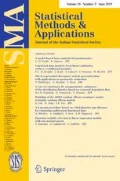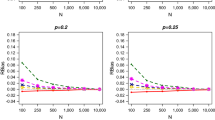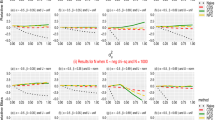Abstract
The purpose of the study is to estimate the population size under a truncated count model that accounts for heterogeneity. The proposed estimator is based on the Conway–Maxwell–Poisson distribution. The benefit of using the Conway–Maxwell–Poisson distribution is that it includes the Bernoulli, the Geometric and the Poisson distributions as special cases and, furthermore, allows for heterogeneity. Parameter estimates can be obtained by exploiting the ratios of successive frequency counts in a weighted linear regression framework. The results of the comparisons with Turing’s, the maximum likelihood Poisson, Zelterman’s and Chao’s estimators reveal that our proposal can be beneficially used. Furthermore, our proposal outperforms its competitors under all heterogeneous settings. The empirical examples consider the homogeneous case and several heterogeneous cases, each with its own features, and provide interesting insights on the behavior of the estimators.


















Similar content being viewed by others
References
Alunni-Fegatelli D, Tardella L (2013) Improved inference on capture recapture models with behavioural effects. Stat Methods Appl 22:45–66
Baksh MF, Böhning D, Lerdsuwansri R (2011) An extension of an over-dispersion test for count data. Comput Stat Data Anal 55:466–474
Bartolucci F, Forcina A (2006) A class of latent marginal models for capturerecapture data with continuous covariates. J Am Stat Assoc 101:786–794
Blumenthal JA, Williams RB, Kong Y, Schanberg SM, Thompson LW (1978) Type A behavior pattern and coronary atherosclerosis. Circulation 58:634–639
Böhning D, Dietz E, Kuhnert R, Schön D (2005) Mixture models for capture–recapture count data. Stat Methods Appl 14:29–43
Böhning D, Schön D (2005) Nonparametric maximum likelihood estimation of population size based on the counting distribution. J R Stat Soc Ser C 54:721–737
Böhning D (2008) A simple variance formula for population size estimators by conditioning. Stat Methodol 5:410–423
Böhning D, Baksh MF, Lerdsuwansri R, Gallagher J (2013) Use of the ratio plot in capturerecapture estimation. J Comput Gr Stat 22:135–155
Borchers DL, Buckland ST (2002) Estimating animal abundance: closed populations. Springer, New York
Bunge J, Barger K (2008) Parametric models for estimating the number of classes. Biom J 50:971–982
Chao A (1987) Estimating the population size for capture–recapture data with unequal catchability. Biometrics 43:783–791
Chao A (1989) Estimating population size for sparse data in capture–recapture experiments. Biometrics 45:427–438
Chiu CH, Wang YT, Walther BA, Chao A (2014) An improved non-parametric lower bound of species richness via a modified good-turing frequency formula. Biometrics 70:671–682
Dorazio RM, Royle AJ (2003) Mixture models for estimating the size of a closed population when capture rates vary among individuals. Biometrics 59:351–364
Farcomeni A (2011) Recapture models under equality constraint. Biometrika 98:237–242
Farcomeni A, Scacciatelli D (2013) Heterogeneity and behavioural response in continuous time capture–recapture, with application to street cannabis use in Italy. Ann Appl Stat 7:2293–2314
Gerritse S, van der Heijden PGM, Bakker B (2015) Sensitivity of population size estimation for violating parametric assumptions in loglinear models. J Off Stat 31:357–379
Guikema SD, Coffelt JP (2008) A flexible count data regression model for risk analysis. Risk Anal 28:213–223
Kuhnert R, Böhning D (2009) CAMCR: computer-assisted mixture model analysis for CaptureRecapture count data. AStA Adv Stat Anal 93:61–71
Lanumteang K (2011) Estimating of size of a target population using capture–recapture methods based upon multi-source and continuous time experiments. Ph.D. thesis, University of Reading
Lanumteang K, Böhning D (2011) An extension of Chao’s estimator of population size based on the first three capture frequency counts. Comput Stat Data Anal 55:2302–2311
Lerdsuwansri R (2012) Generlisation of the Lincoln-Petersen approach to non-binary source variable. Ph.D. thesis, University of Reading
Lindsay BG, Roeder K (1987) A unified treatment of integer parameter models. J Am Stat Assoc 82:758–764
Link WA (2003) Nonidentifiability of population size from capture-recapture data with heterogeneous detection probabilities. Biometrics 59:1123–1130
Mao CX, Lindsay BG (2003) Tests and diagnostics for heterogeneity in the species problem. Comput Stat Data Anal 41:389–398
McCrea RS, Morgan BJT (2014) Analysis of capture–recapture data. CRC Press, Boca Raton
McKendrick AG (1926) Application of mathematics to medical problems. Proc Edinb Math Soc 44:98–130
Meurant G (1992) A review on the inverse of symmetric tridiagonal and block matrices. SIAM J Matrix Anal Appl 13:707–728
Morgan BJT, Ridout MS (2008) A new mixture model for capture heterogeneity. J R Stat Soc Ser C 57:433–446
Niwitpong SA, Böhning D, van der Heijden PG, Holling H (2013) Capturerecapture estimation based upon the geometric distribution allowing for heterogeneity. Metrika 76:495–519
Pledger S (2005) The performance of mixture models in heterogeneous closed population capturerecapture. Biometrics 61:868–873
Rocchetti I, Bunge J, Böhning D (2011) Population size estimation based upon ratios of recapture probabilities. Ann Appl Stat 5:1512–1533
Rocchetti I, Alfó M, Böhning D (2014) A regression estimator for mixed binomial capture–recapture data. J Stat Plan Inference 145:165–178
Scollnik DP (1997) Inference concerning the size of the zero class from an incomplete Poisson sample. Commun Stat Theory Methods 26:221–236
Shmueli G, Minka TP, Kadane JB, Borle S, Boatwright P (2005) A useful distribution for fitting discrete data: revival of the ConwayMaxwellPoisson distribution. J R Stat Soc Ser C 54:127–142
van Der Heijden PG, Bustami R, Cruyff MJ, Engbersen G, Van Houwelingen HC (2003) Point and interval estimation of the population size using the truncated Poisson regression model. Stat Model 3:305–322
Viwatwongkasem C, Kunhert R, Sativipawee P (2008) A Comparison of population size estimators under the truncated count model with and without allowance for contaminations. Biom J 50:1006–1021
Zelterman D (1988) Robust estimation in truncated discrete distributions with application to capture-recapture experiments. J Stat Plan Inference 18:225–237
Acknowledgments
Authors would like to thank the reviewers for the very helpful comments which lead to considerable improvement of the paper as well as to interesting and promising modifications of the proposed estimator. Authors are grateful to the Ministry of Science and Technology, the Royal Thai Government for providing Ph.D. funding for the first author.
Author information
Authors and Affiliations
Corresponding author
Rights and permissions
About this article
Cite this article
Anan, O., Böhning, D. & Maruotti, A. Population size estimation and heterogeneity in capture–recapture data: a linear regression estimator based on the Conway–Maxwell–Poisson distribution. Stat Methods Appl 26, 49–79 (2017). https://doi.org/10.1007/s10260-016-0358-7
Accepted:
Published:
Issue Date:
DOI: https://doi.org/10.1007/s10260-016-0358-7




